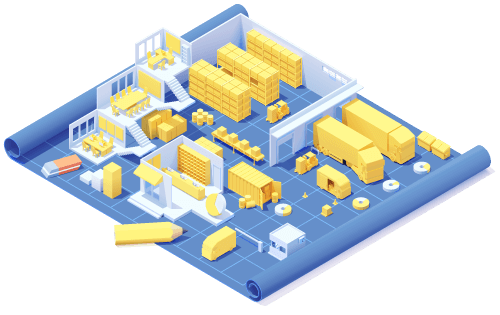Software Solutions to Reduce Inventory Waste
Built For

Software Solutions to Reduce Inventory Waste

Inventory waste is a common issue that affects businesses of all sizes. From overstocked shelves to obsolete products gathering dust in the warehouse, inventory waste can lead to significant financial losses and inefficiencies. Reducing inventory waste is not just about cutting costs; it’s about optimizing resources, improving productivity, and ensuring that your business can meet customer demands promptly.
By leveraging software solutions, businesses gain better control over their inventory, reduce waste, and enhance overall efficiency. In this article, we’ll explore the impact of inventory waste, the benefits of using software solutions, and key features to look for in inventory management software.
Understanding Inventory Waste
Inventory waste encompasses a variety of issues that can plague businesses, leading to inefficiencies and financial losses. To effectively reduce inventory waste, it’s essential to understand the different types and their underlying causes.

Definition and Types of Inventory Waste
Inventory waste is any stock that does not contribute to a business’s revenue. This can be broken down into several categories:
- Overstocking occurs when a business holds more inventory than necessary to meet customer demand. Overstocking ties up capital in unsold goods and increases storage costs.
- Obsolete stock includes products that are no longer in demand or have expired and fall into this category. Obsolete stock often has to be written off, leading to direct financial losses.
- Deadstock is similar to obsolete stock. Deadstock consists of items that have never been sold or have remained unsold for an extended period. Deadstock not only occupies valuable storage space but also represents a lost investment.
Common Causes of Inventory Waste
Understanding the causes of inventory waste is crucial for implementing effective solutions.
Some common reasons include:
- Poor Demand Forecasting: Inaccurate predictions about customer demand can lead to overproduction or overordering, resulting in excess inventory.
- Inefficient Inventory Management: Lack of proper inventory tracking and management practices can lead to stock discrepancies, misplacements, and overstocking.
- Long Lead Times: Extended lead times from suppliers can prompt businesses to order larger quantities to avoid stockouts, leading to overstock.
- Product Lifecycle Mismanagement: Failing to account for products’ lifecycles can result in holding onto items that are no longer viable in the market.
- Seasonal Variations: Businesses that do not account for seasonal demand fluctuations may have excess stock during off-peak periods.
By recognizing these types and causes of inventory waste, businesses can better prepare to address them. Implementing software solutions to tackle these issues head-on can significantly reduce waste, improve efficiency, and boost profitability.
Benefits of Using Software Solutions
Software solutions for inventory management can transform how businesses handle their stock, leading to numerous benefits. These advantages not only help in reducing inventory waste but also contribute to overall business efficiency and profitability.

Improved Inventory Accuracy
One of the primary benefits of using inventory management software is the enhanced accuracy it provides. By automating data entry and tracking inventory in real time, businesses can significantly reduce errors associated with manual processes. Accurate inventory data ensures that companies know exactly what they have in stock, helping to avoid overstocking and stockouts.
Enhanced Demand Forecasting
Inventory management software’s demand forecasting tools use historical sales data, trends, and other relevant information to accurately predict future demand. With better demand forecasting, businesses make more informed decisions about ordering and stocking, reducing the risk of excess inventory and obsolete stock.
Better Visibility and Control
Inventory management software provides comprehensive visibility into inventory levels, movements, and trends, allowing businesses to monitor stock in real time, identify slow-moving items, and make timely adjustments. Enhanced visibility also facilitates better decision-making and strategic planning, enabling companies to optimize inventory levels.
Reduction in Manual Errors and Labor Costs
Manual inventory management is not only time-consuming but also prone to errors. Software solutions automate various inventory-related tasks, such as data entry, stock counting, and order processing, reducing the likelihood of human errors, increasing efficiency, and freeing employees to focus on more strategic activities.
Streamlined Operations
Software solutions integrate various inventory management processes, creating a seamless workflow and streamlining operations, from procurement and warehousing to order fulfillment and shipping. By having a unified system, businesses can eliminate redundancies, reduce lead times, and improve overall operational efficiency.
Enhanced Customer Satisfaction
Accurate inventory management ensures that businesses can meet customer demands promptly. Businesses enhance customer satisfaction and loyalty by avoiding stockouts and ensuring timely deliveries. Happy customers are more likely to return and recommend the company to others, driving growth and profitability.
By leveraging these benefits, businesses can significantly reduce inventory waste and improve their bottom line.
Key Software Features to Reduce Inventory Waste
To effectively reduce inventory waste, leveraging software solutions with specific features designed to optimize inventory management is essential. Here are the key features to look for:

Real-time Inventory Tracking
Real-time inventory tracking allows businesses to monitor stock levels continuously. This feature provides up-to-the-minute data on inventory movements, enabling companies to:
- Prevent Overstocks and Stockouts: Accurate, real-time information helps businesses maintain optimal stock levels and avoid the pitfalls of excess inventory and shortages.
- Enhance Decision-Making: Real-time data supports quick and informed decisions regarding reordering, promotions, and markdowns.
- Improve Accuracy: Continuous tracking reduces discrepancies between actual stock and recorded data, ensuring more reliable inventory counts.
Reorder Alerts
Inventory software streamlines replenishment by generating purchase reorder alerts when stock levels reach a predefined threshold. The benefits include:
- Maintaining Optimal Stock Levels: Reorder alerts help ensure that businesses always have the right amount of stock on hand.
- Reducing Manual Effort: Reorder alerts eliminate the need for manual inventory tracking, saving time and reducing the risk of human error.
- Enhancing Supplier Relationships: Consistent and timely orders help build stronger relationships with suppliers, leading to better terms and reliability.
Demand Forecasting Tools
Accurate demand forecasting is crucial for minimizing inventory waste. To predict future demand, software solutions with advanced forecasting tools analyze historical sales data, market trends, and seasonal patterns. Benefits include:
- Reducing Overstock and Obsolete Stock: By aligning inventory levels with predicted demand, businesses can avoid excess inventory and reduce the risk of holding obsolete stock.
- Optimizing Stock Levels: Precise forecasting ensures that businesses stock the right amount of inventory to meet customer demand without overcommitting resources.
- Enhancing Strategic Planning: Forecasting tools provide insights that support long-term planning and strategic decision-making.
Inventory Optimization
Optimization features help businesses balance inventory levels to minimize waste while meeting customer demand. This includes tools for:
- Identifying Slow-Moving and Deadstock: By pinpointing items that are not selling well, businesses can take corrective actions, such as promotions or discounts, to clear excess stock.
- Balancing Supply and Demand: These features ensure that inventory levels are adjusted according to changes in demand, reducing the likelihood of excess stock.
Integration with Other Systems
For a holistic approach to inventory management, software solutions should integrate seamlessly with other business systems such as QuickBooks and eCommerce platforms. Integration benefits include:
- Unified Inventory and Order Management: Integrated systems provide a single source for inventory management, sales orders, and customer data reducing inconsistencies and errors.
- Enhanced Operational Efficiency: Businesses streamline operations and improve coordination by connecting inventory management with eCommerce and financial systems.
- Comprehensive Business Insights: Integrated systems offer a complete view of business operations, enabling more informed decision-making and strategic planning.
By incorporating these key features, businesses can significantly reduce inventory waste, improve efficiency, and enhance profitability.
Reducing Inventory Waste FAQs
What is inventory waste, and why is it important to reduce it?
Inventory waste refers to stock that does not contribute to revenue, such as overstock, obsolete stock, and deadstock. Reducing inventory waste is crucial for saving costs, optimizing resources, and improving business efficiency. Minimizing waste helps businesses maintain optimal inventory levels, reduce storage costs, and avoid financial losses.
How can software solutions help in reducing inventory waste?
Software solutions enhance inventory accuracy, provide real-time tracking, improve demand forecasting, and facilitate reordering processes. These features help businesses maintain optimal stock levels, reduce manual errors, and streamline operations, ultimately minimizing inventory waste and improving overall efficiency.
What are the critical features of inventory management software that help reduce waste?
Key inventory management features for reducing waste include:
- Real-time inventory tracking.
- Reorder alerts.
- Demand forecasting tools.
- Inventory optimization.
- Integration with other business systems, such as QuickBooks and eCommerce platforms.
These features ensure accurate inventory data, timely replenishment, optimized stock levels, and comprehensive business insights, all contributing to reduced inventory waste.
How does real-time inventory tracking benefit businesses?
Real-time inventory tracking provides up-to-date data on stock levels and movements, preventing overstock and stockouts. It enhances decision-making by providing accurate information, reduces discrepancies, and supports efficient inventory management, ultimately helping to minimize waste and improve accuracy.
Why is integrating inventory software with other business systems important?
Integration with QuickBooks and eCommerce platforms ensures unified data management and comprehensive insights into business operations. It enhances operational efficiency by streamlining processes across departments, reducing inconsistencies, and supporting better decision-making, all of which contribute to reducing inventory waste.
Call us at 817-870-1311




